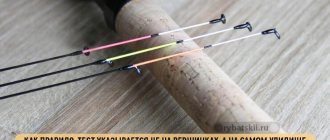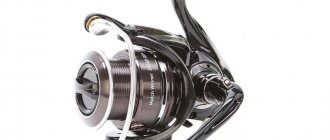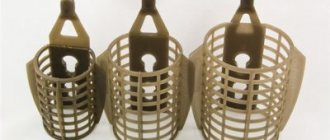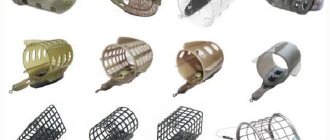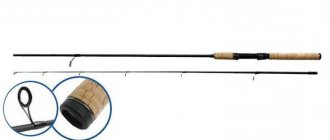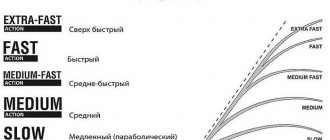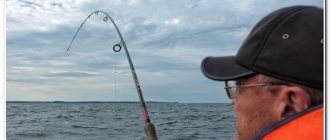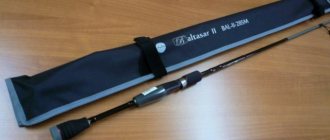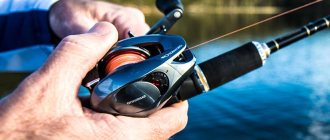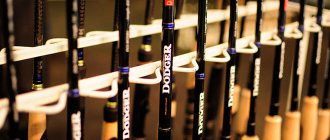Good afternoon Today we will talk about spinning rods, and to be more precise, about their tip. We all love to fish and sooner or later our rods break, this is a common thing. But most often, due to our own negligence, the tip of a spinning rod becomes unusable. This article will go into detail We are talking about this very part of the rod.
So, what is a spinning rod tip? The tip of a spinning rod is, simply put, the end of the rod, very thin and fragile, which ensures its flexibility, and in some cases can even signal a bite, but this is only with a large catch.
Without this part, our tackle will most likely break if a large fish bites. We will not dwell in detail on the concept of the tip, since every fisherman knows what it is.
But what to do if it does break? Of course, a broken tip is the worst case scenario short of fatally breaking the rod, but there's no need to panic. There will always be a way out.
There are two ways to solve this problem:
- The first is a complete replacement if the tip cannot be repaired.
- The second is manual repair.
First, determine the extent of damage to your tip, is it worth shelling out and getting a new one or can it be repaired?
Action plan

Let's consider the first method - complete replacement of the tip. The moment a fisherman realizes that this part of the fishing rod cannot be repaired, he begins to think about buying a new tip. The choice of tops is huge and you need to be able to choose them correctly.
Your action plan should be like this:
- Determine the model of your spinning rod;
- Determine the diameter of the tip;
- Go to the store and consult with a specialist;
You don't need too many actions, these three are enough. You can do it differently - in a simpler way. Take your spinning rod with you and go to the store. There they will select the right part for your model. The first method is quite simple: you take the rod, take it, they replace it for you - you pay.
The second method, that is, manual repair, is better than the first. It would seem easier to buy a new spinning rod tip than to tinker with it yourself. But that’s not the case; it’s worth buying a new part only when it’s no longer possible to fix it. In all other cases, your own hands and head will help you.
By doing repairs yourself, you will eventually develop a skill that will be useful to you later.
For example, when fishing, when you don’t always have tools with you, you can easily repair the tip of a spinning rod using scrap materials. And special craftsmen can earn money by repairing tips and not only them, but also entire rods, because they have experience in this thanks to their own labor.
In general, repair of the top consists of the following:
- Select the tip, preferably without rings, but if it turns out that it does have rings, then carefully trim the glued part and remove them.
- Proper selection of the formation is also necessary, otherwise the load on the form will be unevenly distributed.
- Visually determine which ring of the larger part of the broken spin needs to be inserted from.
- Under the place where the ring we need is attached needs to be cleaned with some kind of tool (grinder or knife). This is done so that the carbon does not delaminate.
- Take super glue (preferably one that has better contact with plastic) and pour it into the carbon part. We slightly prime the pre-prepared fiberglass part and then insert these parts into one another.
- We tightly wrap the black thread around the gluing area.
- We apply glue to the wound thread to strengthen the connection and seal it.
- Wait for the glue to dry and your top is ready.
Pass Ring
Regarding the preparation of the tip, it should be taken into account that the rings must be taken from the same spinning rod and, using the priming principle, we prime the desired part of the ring and the surface of the whip, wrap it with thread and cover it with glue on top.
The distance between the rings can be adjusted yourself, although it is advisable to proceed from the original dimensions.
You can modify the thick part of the whip with a knife until it matches the diameter in the carbon part.
The test characteristics of the spinning rod will not change much, although the rod will become a little shorter - this will not hinder you in any way when fishing.
There is also another repair method in which the length and characteristics do not change:
- First, you need to select a dense but flexible rod suitable for the role of a connector (under no circumstances use hard rods or needles, because if bitten, your tip may break again).
- The rod should fit tightly into both ends of the broken tip. After you are sure that a good connector has been selected, we proceed to preparing the epoxy resin. This resin can be purchased at any market or store. It consists of glue and hardener.
- Next, they need to be mixed in the same proportion: 1 to 1. If you have problems with the proportions, then there are probably instructions on the tubes. Apply glue to both parts of your rod, insert it into both parts of the spinning rod and connect the broken end to the main rod.
- Afterwards, wait 30-40 minutes until complete gluing. In principle, these are all the ways to repair the tip of your tackle.
Spinning rod
The rod is the main element of spinning tackle; the success of fishing largely depends on it. In its shape, a spinning rod is a thin, long cone, the thick end of which, on which the handle is located, is called the butt, and the thin, opposite end is called the tip.
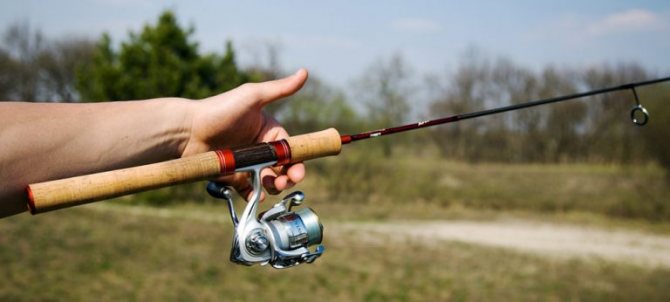
A spinning rod must be durable, light in weight, and provide high sensitivity. Spinning rods differ in the material from which they are made, test, class and length.
Spinning material
Modern spinning rods have high demands on strength and weight. The spinning rod can be made of carbon fiber, fiberglass, bamboo or metal.
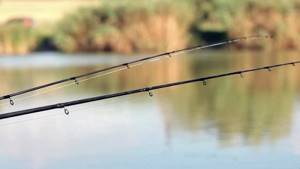
- Fiberglass is a popular material for the manufacture of spinning rods, but is now almost completely replaced by carbon fiber spinning rods. Fiberglass spinning rods are heavy and flexible. Inexpensive spinning rods are most often made from fiberglass. Fiberglass rods are often used as spinning rods for trolling.
- Carbon fiber is the most modern material for making spinning rods. Carbon fiber for spinning rods is also called carbon and graphite. Carbon fiber spinning rods have low weight, good rigidity and high flexibility. The properties of a carbon fiber spinning rod depend on the modulus of the graphite content. The higher the modulus of the graphite from which the spinning rod is made, the more rigid and sensitive the rod will be, but at the same time more fragile, requiring more careful handling.
- Composite - the spinning rod is made from a mixture of fiberglass and carbon fiber. Composite spinning rods combine the best qualities of both materials and have optimal strength and good rigidity.
- Metal - in the old days, many spinning rods were made of metal. They had high strength, but quite a lot of weight. Currently, metal spinning rods are almost out of use.
- Bamboo is a popular material for making spinning rods in the past. Bamboo spinning rods were quite durable and significantly lighter in weight than metal spinning rods. Currently, bamboo spinning rods, like metal spinning rods, are practically out of use.
Spinning test
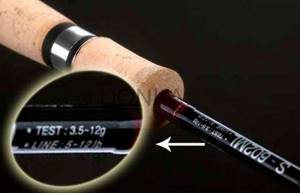
The spinning test is the weight of the lures recommended by the spinning rod manufacturer. The spin test can be reported in grams or ounces. When designating a spinning test, two values are indicated: the minimum weight of the bait that can be thrown by this rod and the maximum weight of the bait that can be thrown by this spinning rod without overloading the rod blank. The angler should follow the bait weight recommendations specified by the spinning rod manufacturer. When casting a bait weighing less than the minimum spinning test, the angler will not be able to cast it a decent distance, and will also not be able to feel the action of the bait when retrieving it. When casting a bait weighing more than the maximum spinning rod test, the rod is overloaded, which can lead to breakage of the rod blank. The spinning test is directly related to the class of the rod.
Spinning rod class
The spinning class directly depends on the test of the spinning rod and indicates its power, in terms of the weight of the baits it throws. The division of spinning rods into classes is quite arbitrary and differs among different manufacturers.
Traditionally, spinning rods are divided into 4 main classes: ultra-light, light, medium and heavy classes. In addition, some manufacturers of spinning rods distinguish intermediate classes.
- Ultra Light class - with an upper dough limit of up to 7 grams. Ultra-light class spinning rods are designed for fishing with small spinners, small oscillating spoons, microjigs and small wobblers. Ultralight spinning is most often used to catch fish weighing no more than 1.5-2 kg. Most often these are small perches and pikes, chubs, graylings and trout. The length of an ultralight spinning rod is most often 1.6-2.1 meters.
- Light class (Light) - spinning rods with a dough of 7-15 grams. Rotating and oscillating spoons, jigs and wobblers are used as bait. Light-class spinning rods can catch fish weighing up to 4-5 kg. The length of rods most often ranges from 2.1 to 2.4 meters.
- Middle class (Medium) - spinning rods with a dough of 15-40 grams. When fishing with a middle-class spinning rod, heavy rotating and oscillating spoons, jig baits and large wobblers are used as bait. With a middle class spinning rod you can successfully catch large fish weighing up to 6-8 kg: pike, pike perch, asp, small catfish, taimen and salmon. The length of middle class rods most often ranges from 2.4 to 3.3 meters.
- Heavy class - spinning rods with a dough of 40 grams or more. Heavy class spinning rods are used for catching the largest trophies: pike, walleye, catfish. Heavy class rods are used for sea trolling fishing.
You may be interested in: Perch fishing
Length
Spinning rod manufacturers produce spinning rods in a variety of sizes designed to catch a wide variety of fish in a variety of conditions. European manufacturers of spinning rods measure the length of spinning rods in meters, American manufacturers traditionally indicate the length of spinning rods in feet and inches.
Most spinning rods have a length from 160 to 360 cm. The longer the spinning rod, the longer the cast can be made with it, but as the length of the spinning rod increases, its weight increases and its maneuverability decreases. Long spinning rods are designed for fishing in large open reservoirs and for fishing from the shore. Shorter spinning rods are designed for fishing on small rivers with overgrown banks, as well as for fishing from a boat.
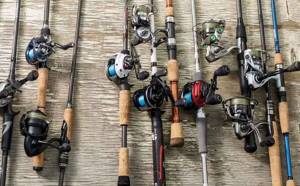
Most modern spinning rods are available in a two-part version. They are most convenient for transportation, easy to manufacture and have good technical characteristics.
Single-legged spinning rods are available, they are quite rare and are intended for special purposes, for example for casting competitions.
For those fishermen who travel a lot, there are special multi-part fishing rods called travel. Recently, telescopic spinning rods have become increasingly common, which usually consist of 5-6 telescopic parts.
Spinning rod structure
The structure of a spinning rod is the most important characteristic of a fishing rod. The casting distance of this spinning rod, as well as the sensitivity of the spinning rod, depends on the structure of the rod.
The action of a spinning rod is determined by the time it takes for the rod to return to its original state after casting. The closer the spinning rod's action is to fast, the stiffer it is and the higher its sensitivity, the better all the vibrations are transmitted to the angler's hand, but as the rigidity of the spinning rod increases, the casting range of the bait decreases.
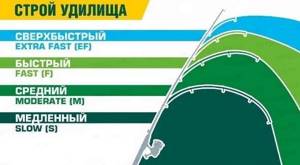
In order to determine the structure of a spinning rod, you need to look at where the spinning rod bends under load. With an ultra-fast action spinning rod, only the very tip of the spinning rod bends, while with a slow action spinning rod, the entire spinning rod bends under load.
Based on the action, there are spinning rods of super-fast, fast, medium and slow action.
- Extra Fast action
– only the very tip of the spinning rod bends, no more than ¼ of the length of the rod. An ultra-fast spinning rod is well suited for twitching and jig fishing. Ultra-fast spinning rods have maximum sensitivity, but have a shorter casting range and are less effective at softening the jerks of fish when playing. - Fast action
- under load, the spinning rod bends from half the length of the rod. Fast action spinning rods are also mainly used for twitching and jigging. - Medium action (Moderate)
– a medium action spinning rod bends up to ¾ of its length. The most universal and common rod structure among anglers. Can be used for fishing with a wide variety of spinning lures. - Slow action
– the spinning rod bends along its entire length; this spinning rod action is often called a “parabolic” action. Slow action spinning gives the longest cast and softens the jerks of the fish well when playing. Slow-action spinning rods are best suited for fishing with rotating and oscillating spoons; they are poorly suited for twitching and jigging.
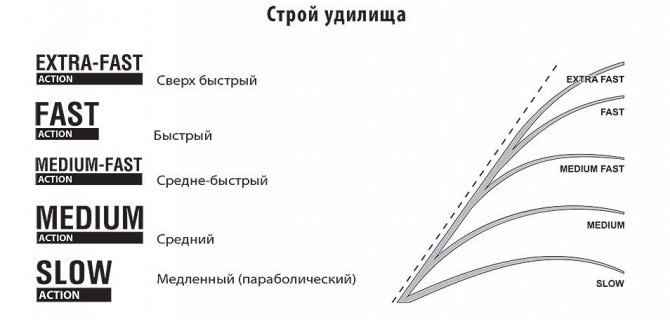
Some manufacturers of spinning rods produce models of spinning rods not only of the 4 main types of action, but also intermediate ones, for example, medium-fast (ModerateFast). In addition, some manufacturers indicate the recommended method of fishing with this spinning rod, for example, a spinning rod for twitching or jigging.
Estimated fishing location
Very often, the choice of spinning rod depends on the body of water where you plan to fish.
When fishing at sea, as well as in the northern and eastern regions of Russia, large and strong fish are often caught, so you should use the most powerful and durable spinning rods.
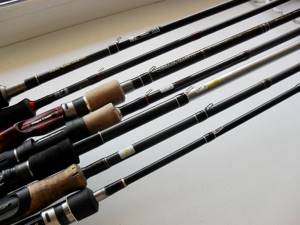
When fishing on a large lake, large reservoir or large river (more than 10 meters wide), where there are often deep waters and strong winds, you should use long, stiff spinning rods. Fishing in such conditions is most often carried out using jig heads with silicone baits, rotating and oscillating spoons, and wobblers. The optimal spinning rod length for these conditions will be 2.8-3 meters, the rod action is Fast or Extra Fast, the test weight is from 7 to 30 grams.
For fishing on a medium-sized pond, lake and river, a spinning rod with a length of 2.1-2.4 meters, a Fast or Extra Fast action, and a test weight of 3-15 grams is well suited. For fishing in such conditions, small spoons, microjigs and small wobblers are used.
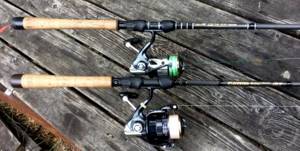
When fishing on a small river or stream, with banks overgrown with trees and bushes, you should use a spinning rod of small length 160-180 cm, with a fast action and a cast of 1 to 7 grams. This rod allows you to make precise casts in cramped conditions.
When fishing from a boat or boat, you should use a rod with a length of 210-240 cm, Extra Fast action, test up to 28 or up to 40 grams. Fishing is most often done with jigs and wobblers.
Adviсe

- If the tip of your spinning rod breaks while fishing , then you can fix it with the help of improvised materials for a while; it is better to carry out a complete repair at home, where you have all the necessary tools, or send it to a workshop.
- Do not use hard metal objects as stated above, you will only make the damage worse.
- To obtain a beautiful and smooth surface like on factory products , use epoxy glue, applying it to the part, while the part must be slowly rotated either manually or using an electric drive. It is very important that the glue sets at least on the outer layer, then dry it with a hairdryer.
- You cannot lift a fish , even a small one, above the water - this risks breaking your fishing line, and in the worst case, breaking your gear.
- At the last stage of landing fish , make sure that the length of the fishing line from the fish to the tip is not significantly less than the length of the spinning rod. You risk breaking your rod when catching fish in a net or by hand.
- Before each fishing trip, carefully inspect your gear to avoid further problems.
- Do not cast until you are sure that the line passes freely through all the guides.
- In the last meters of retrieving the catch, it is better to slow down the speed of reeling in the reel and lift the spinning rod up. This will help you avoid snagging and breaking the tip.
- When moving from place to place, carry the rod perpendicular to the ground to avoid breakages; if there are trees nearby, then carry it with the handle forward.
- Before and after fishing, wipe the spinning rod at the joints with a rag.
- If the knees are jammed , then under no circumstances should you use organic solvents, since in this case the varnish will dissolve and the knees at the joint will stick together forever.
- To assemble and disassemble gear, only special silicone-based compounds should be used. They are sold in fishing stores.
Problems will pass you by provided you follow these instructions. This concludes the story about the spinning tips. All the most important and necessary things were described in this article. Happy fishing and big catch!
Spinning reels
A spinning reel is one of the most important and perhaps the most expensive element of spinning equipment. There are three main types of spinning reels: spinning reels, spinning reels, and baitcasting reels.
Inertia coils
The first spinning reels were the so-called inertial reels. Inertial reels were popular among Soviet fishermen: “Nevskaya-100”, “Nevskaya-150” and “Kyiv”. Nowadays, inertial coils have given way to other types of coils.
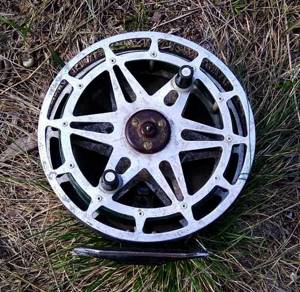
Inertial coils are simple to design. They consist of: a drum for winding the fishing line, a friction brake and a leg for attaching the reel to the fishing rod.
An inertial reel is well suited for fishing when heavy bait is used and long distance casting is not required. The advantages of inertial coils include low cost compared to other types of coils and simplicity of design, which ensures high reliability of such coils.
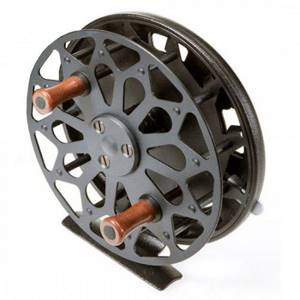
For all their advantages, inertial reels require a certain amount of experience and dexterity from the angler to cast bait. The inertia of the reel needs to be slowed down and stopped at the end of the cast, otherwise you will end up with a “beard” of fishing line that will take a long time to untangle.
It is precisely because of the difficulty with casting and the frequent formation of “beards” that inertial reels have lost popularity among anglers to more modern, inertia-free reels.
Spinning reels
The spinning reel is the most popular type of spinning reel among domestic fishermen. The appearance of a spinning reel is known to every fisherman; because of their appearance, such reels are often called “meat grinders” by fishermen.
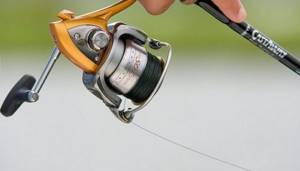
A spinning reel consists of a spool, a line handle with a roller, a rotating rotor, a body containing the reel mechanism, a handle and a leg with which the reel is attached to the spinning reel seat. Inertia-free reels are equipped with a front or rear friction brake.
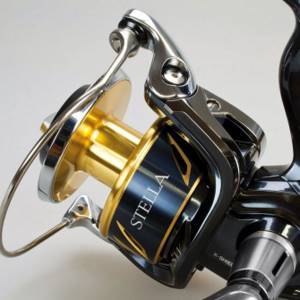
Inertialess reels are easy to use, universal in terms of fishing method, thanks to a large number of models, they provide the fisherman with the opportunity to choose a reel that is suitable for fishing conditions and budget.
It should be noted that a high-quality spinning reel costs a lot and requires careful treatment and care.
Multiplier reel for spinning rod
Multiplier reels are still not very common among domestic fishermen, although they are very popular abroad. The popularity of these reels is growing every year and more and more anglers are no longer avoiding them. Many spinning anglers, who pick them up for the first time and make a few casts, begin to understand that even a novice angler can handle such a reel.

Multiplier reels combine the advantages of both inertial and inertialess reels, but at the same time have a more complex design.
It is not recommended to install a multiplier reel on a regular spinning rod; you should purchase a casting spinning rod specifically designed for fishing with a multiplier reel; such a spinning rod has better balance, an appropriate handle length and a larger number of rings, and a reel seat specifically designed for the multiplier.
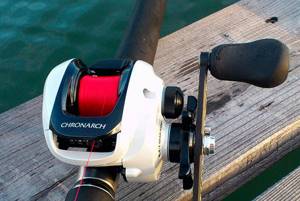
Multiplier reels have high power, are reliable, easy to use, and provide high sensitivity of the gear during the fishing process. At the same time, multiplier reels require certain equipment and experience in casting bait, they require adjustment of the braking system to the fishing conditions and the bait used, and have a higher cost compared to other types of reels.
